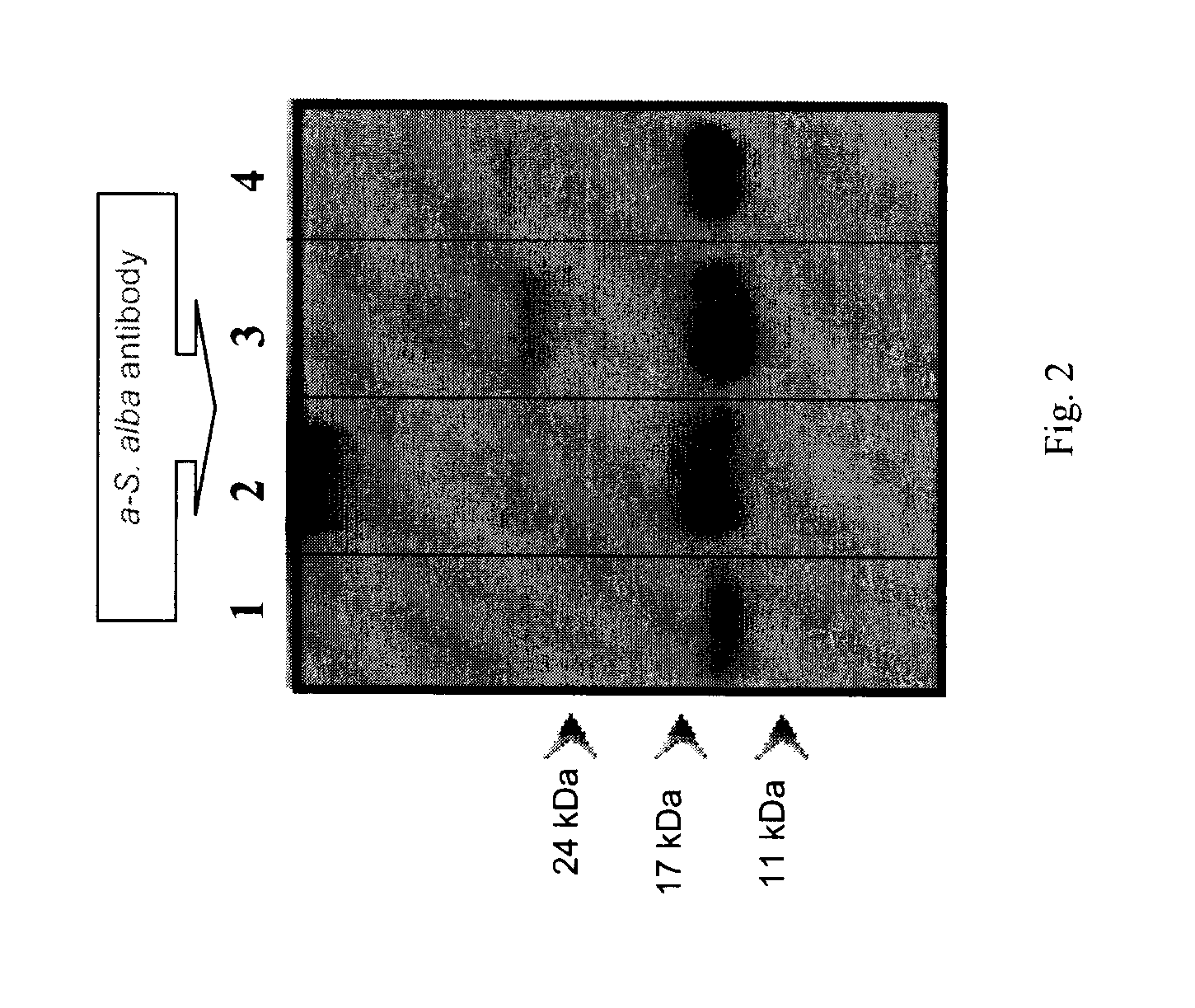Process of aqueous protein extraction from Brassicaceae oilseeds
a technology of brassicaceae and aqueous protein, which is applied in the field of process of aqueous protein extraction from brassicaceae oilseeds, can solve the problems of long and complicated process, low product yield, and low ph of extraction medium, and achieve the effect of enhancing the solubility of napin under such low ph conditions
- Summary
- Abstract
- Description
- Claims
- Application Information
AI Technical Summary
Benefits of technology
Problems solved by technology
Method used
Image
Examples
example 1
Separation, Purification and Electrophoresis Based Peptide Profiling of Cruciferin and Napin from B. Napus and S. Alba
[0122]Seed meals of B. napus and S. alba were utilized to extract, separate and purify cruciferin and napin according to the chromatographic separation method of Bérot et al. (2005) with minor modifications as described above. Purified dry proteins were reconstituted in super-Q water to have known concentration of protein and separated by SDS-PAGE.
[0123]Napin polyclonal antibodies prepared using the method disclosed above were purified and used to recognize napins in protein extracts by western blotting technique.
[0124]Electrophoresis separation of purified cruciferin and napin is provided in FIGS. 1A and 1B.
[0125]As shown in FIG. 1A, cruciferins of both species were separated into polypeptide bands that are distributed within molecular mass range of 69 to 18 kDa under non-reducing conditions. Cruciferins of Brassicaceae are expressed by multigene families (Breen an...
example 2
Solubility Differentiation of Proteins According to pH
[0128]A series of B. napus and S. alba seed meal dispersions (50 ml of 0.25%, w / v) in super-Q water were prepared at different pH values in the range of pH 1.0 to 12.0. The pH of these slurries was adjusted using HCl or NaOH (0.1M, 1M or 6M as appropriate) while stirring continuously at room temperature (22° C.). Extraction of soluble protein was accomplished by stirring the dispersion on a magnetic stirrer at room temperature for 30 minutes and maintaining the pH at the desired value. The extraction step was terminated by separating insoluble materials by centrifugation (10,000×g, 15 min, 20° C.). The supernatant was filtered to remove floating particles using a Whatman #1 filter paper under vacuum. The soluble protein content of the extract was determined using Modified Lowry assay as disclosed above. Soluble protein at each pH was calculated as a percentage fraction of total meal protein (% N×6.25) and plotted against extracti...
example 3
Extraction of Napins at Acidic pH
[0131]S. alba meal was used for this study. Experiments were designed to include meal-to-solvent ratio (1:20 to 1:89.5, w:v), extraction time (0.32 to 6.2 h) and temperature of extraction (15.9° C. to 46.1° C.) as independent variables. The responses or dependant variables were total soluble proteins extracted. Experiments were carried out as combinations of a Central Composite Rotatable Design and data was analysed using Response Surface Methodology (SAS, Statistical Analysis System, Release 8.2).
[0132]Meal extraction and separation of soluble protein containing liquid fraction were carried out at pH 4.5 as described in Example 2. Total protein content of the extracts was determined using modified Lowry assay. Only selected extractions based on total protein content were subjected to polypeptide profiling by SDS-PAGE.
[0133]An increase in meal-to-solvent ratio and temperature, increased the protein content that was solubilised (FIG. 5). According to ...
PUM
| Property | Measurement | Unit |
|---|---|---|
| temperature | aaaaa | aaaaa |
| temperature | aaaaa | aaaaa |
| temperature | aaaaa | aaaaa |
Abstract
Description
Claims
Application Information
 Login to View More
Login to View More - R&D
- Intellectual Property
- Life Sciences
- Materials
- Tech Scout
- Unparalleled Data Quality
- Higher Quality Content
- 60% Fewer Hallucinations
Browse by: Latest US Patents, China's latest patents, Technical Efficacy Thesaurus, Application Domain, Technology Topic, Popular Technical Reports.
© 2025 PatSnap. All rights reserved.Legal|Privacy policy|Modern Slavery Act Transparency Statement|Sitemap|About US| Contact US: help@patsnap.com



